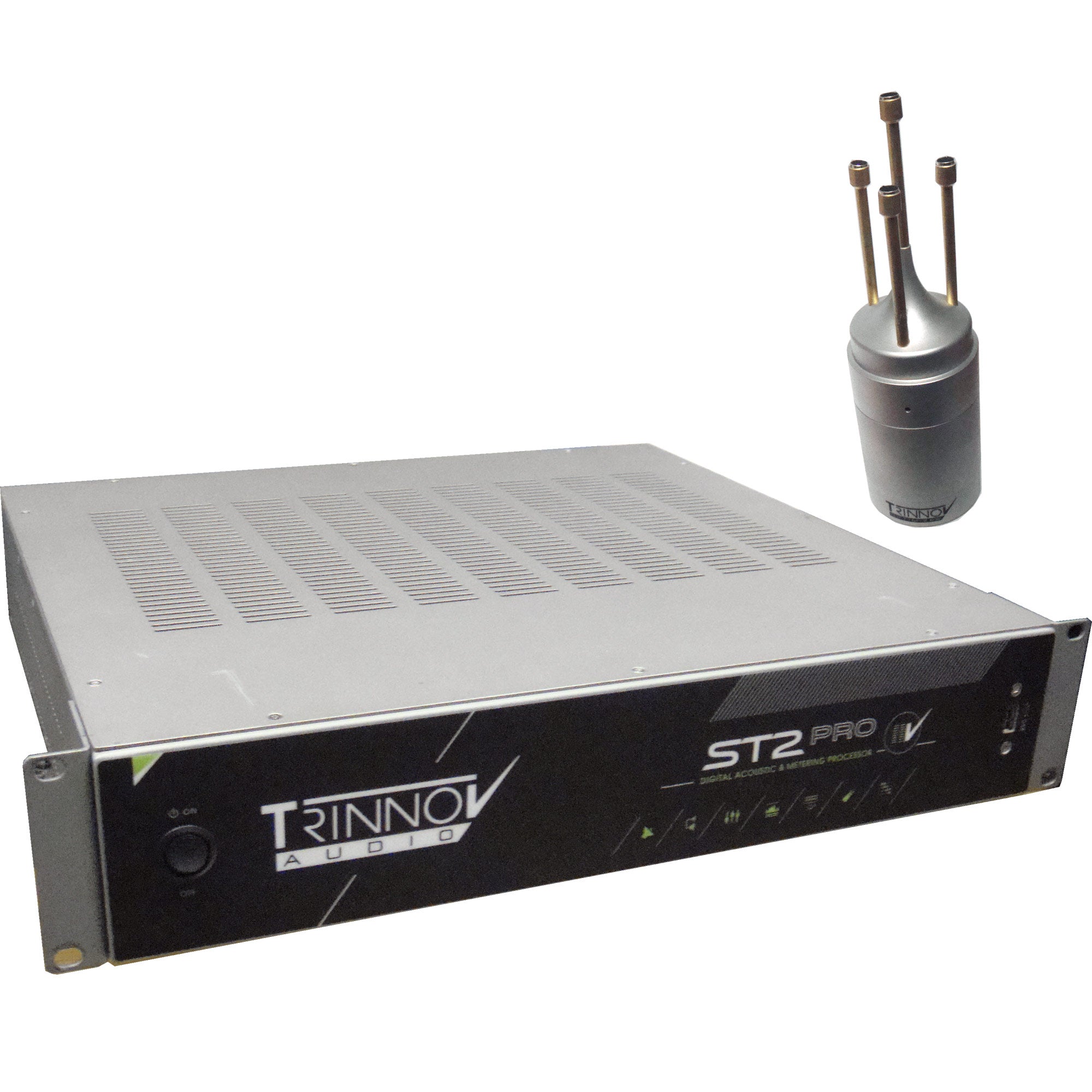
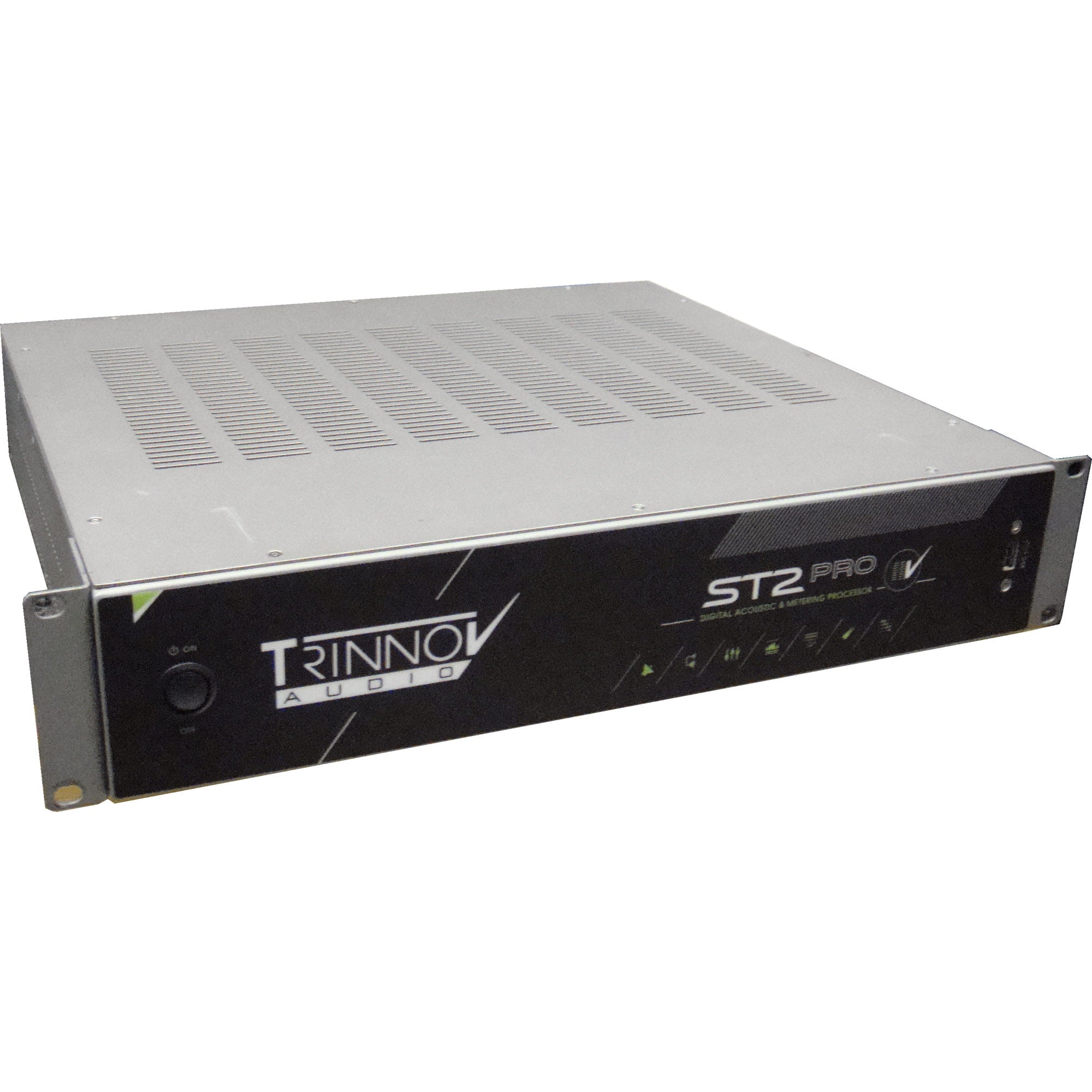
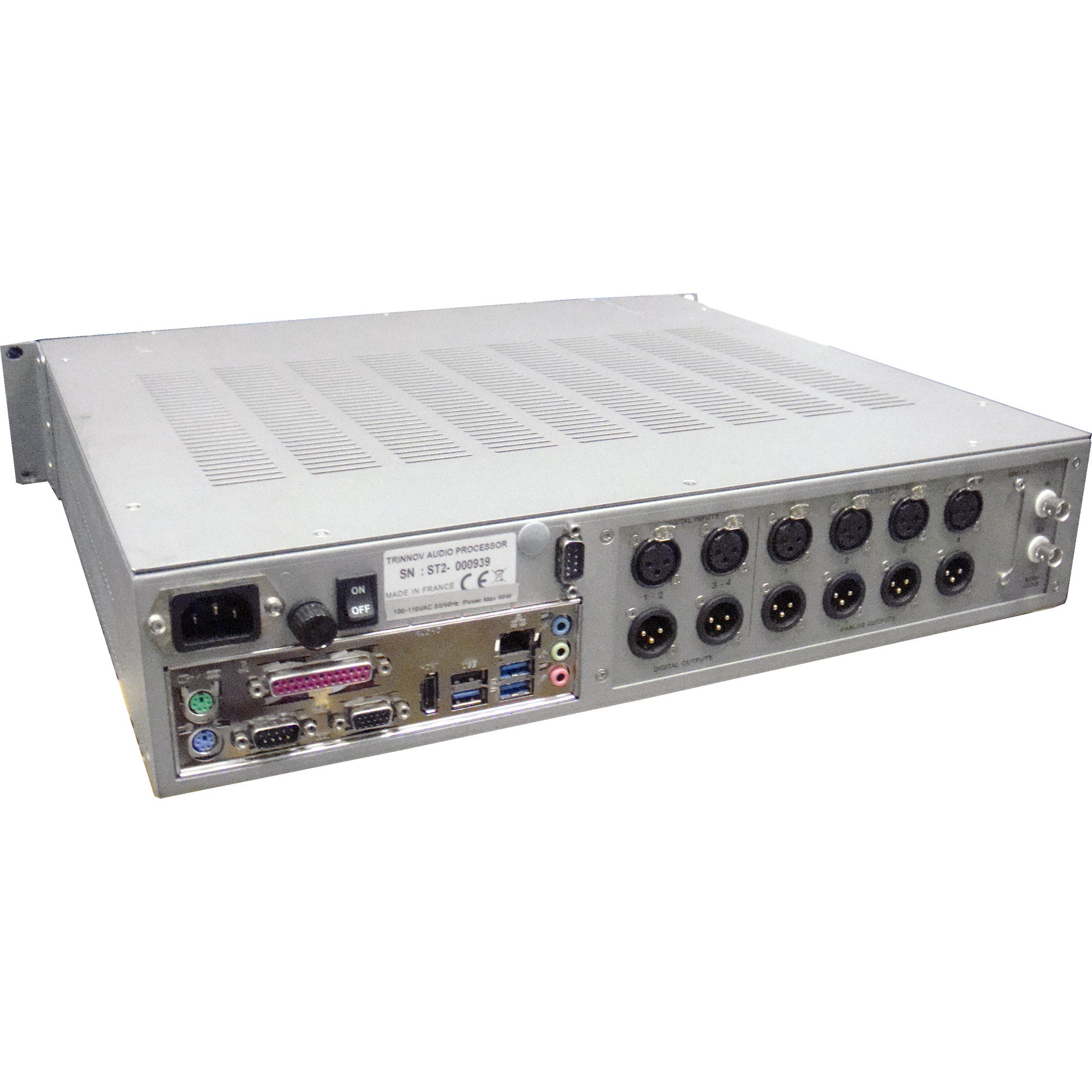
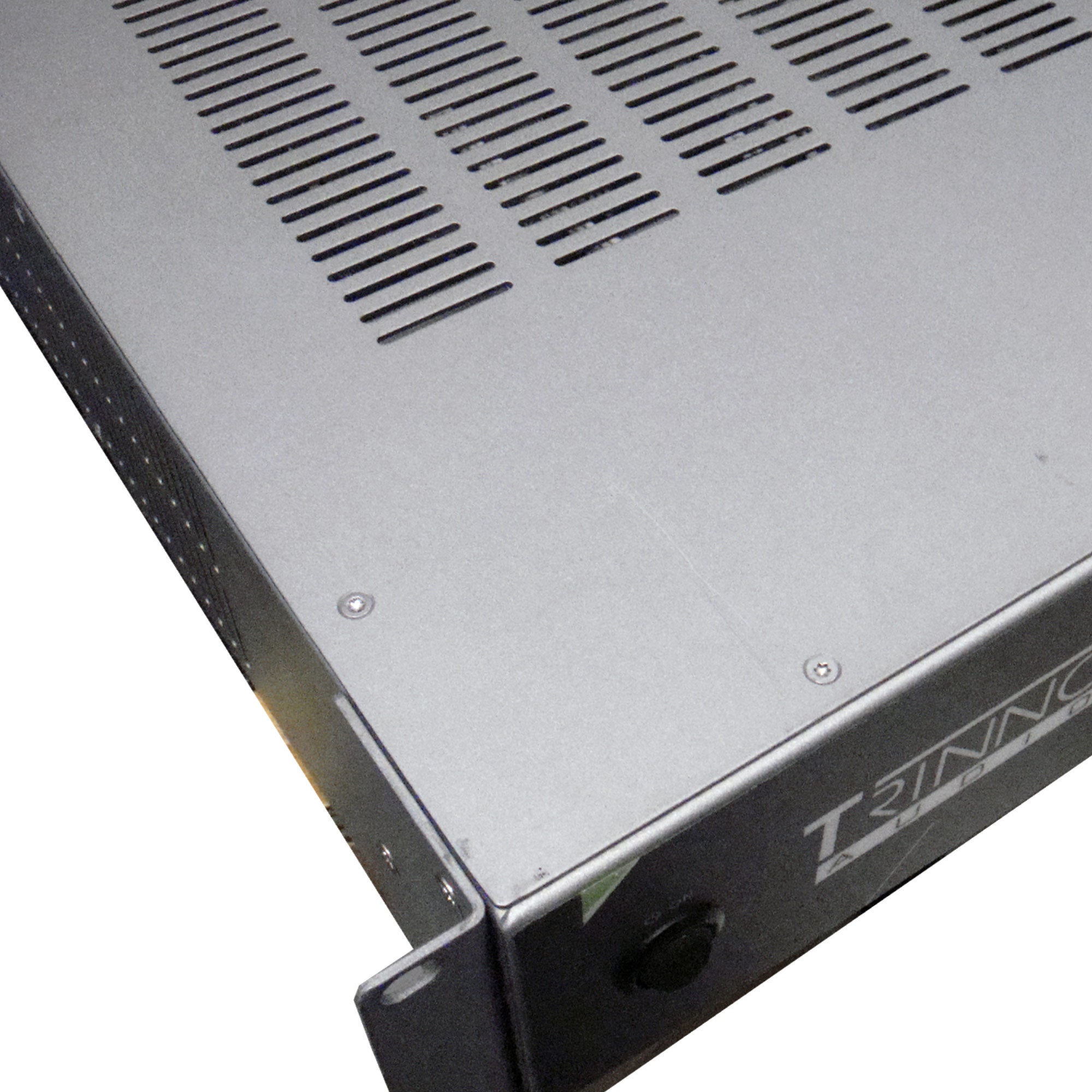
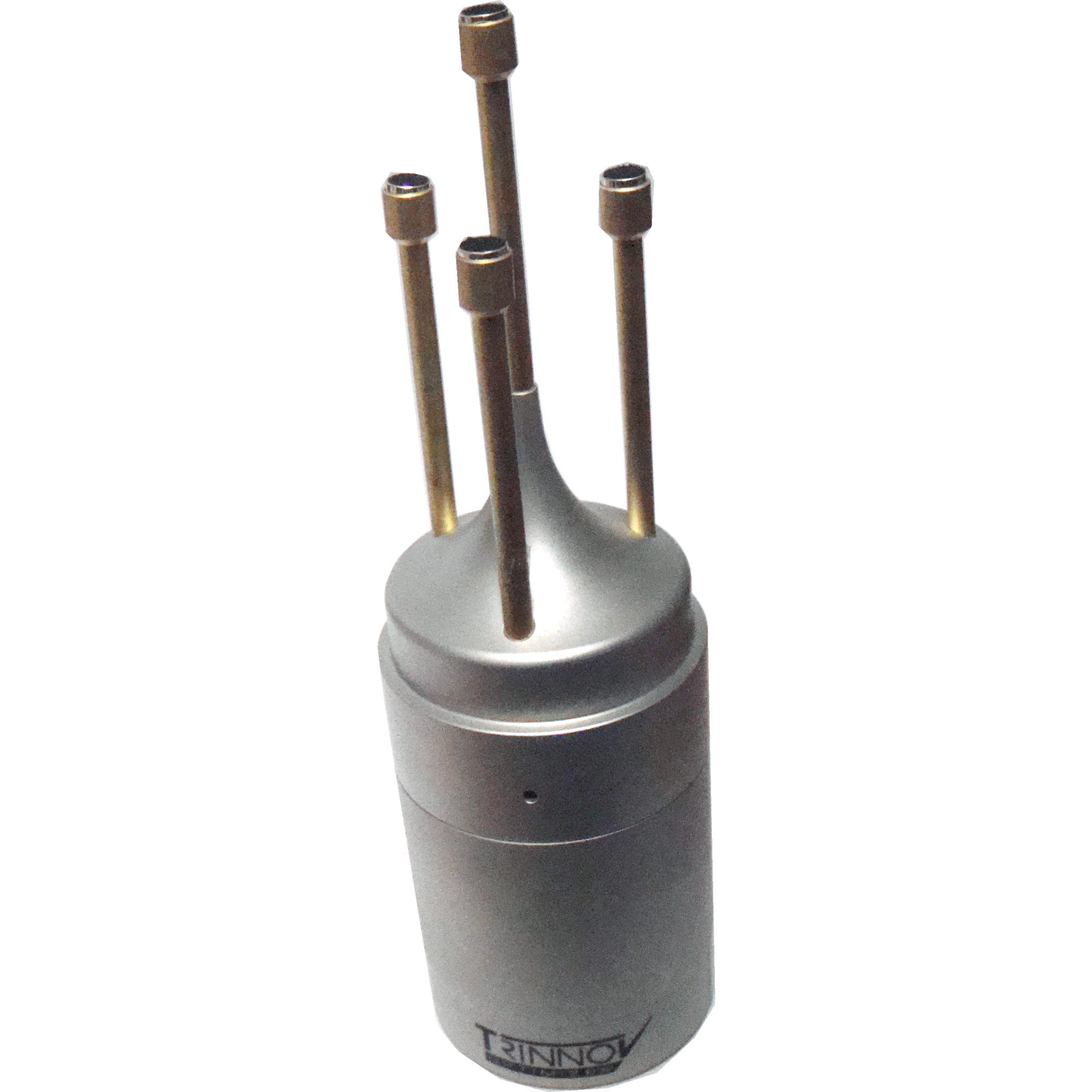
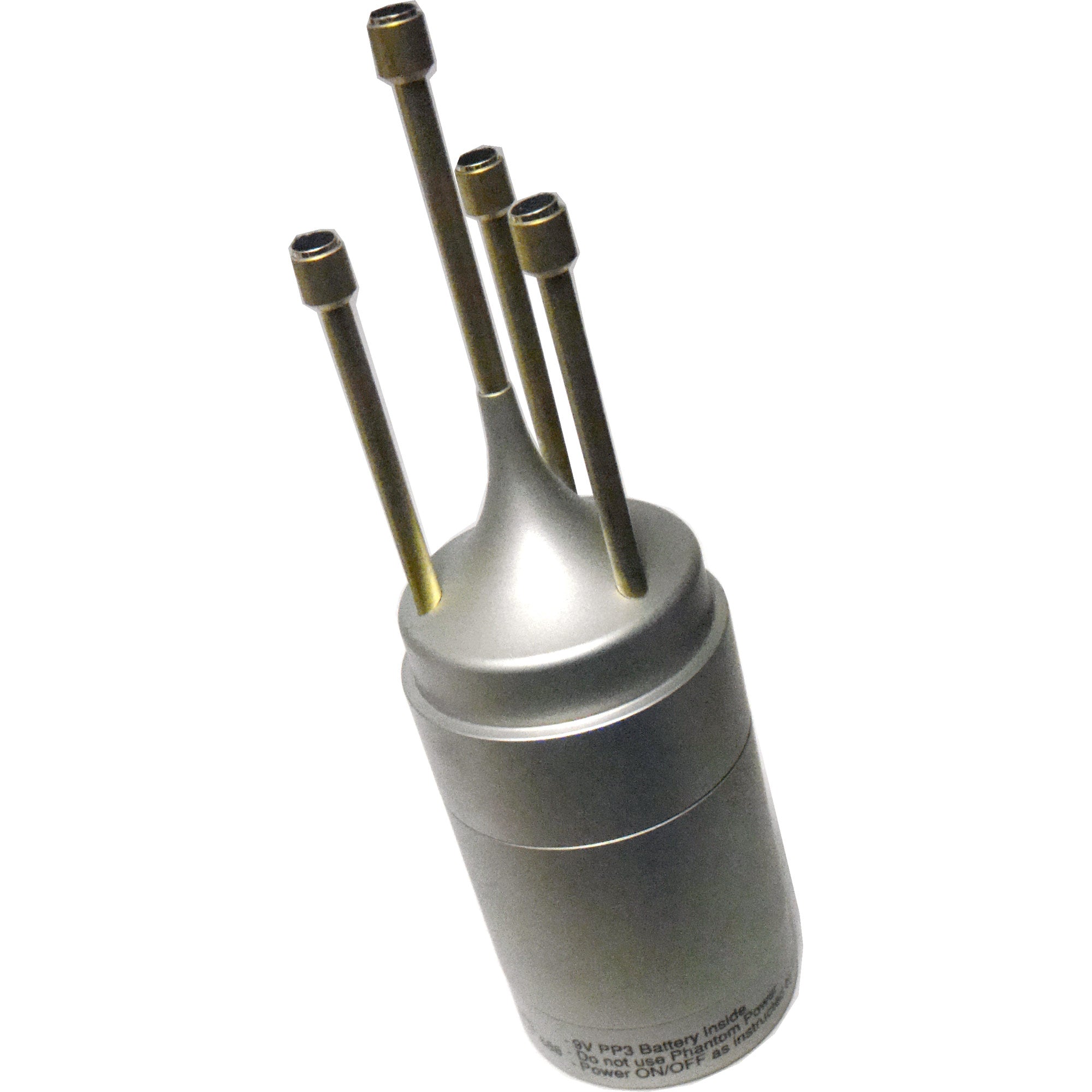
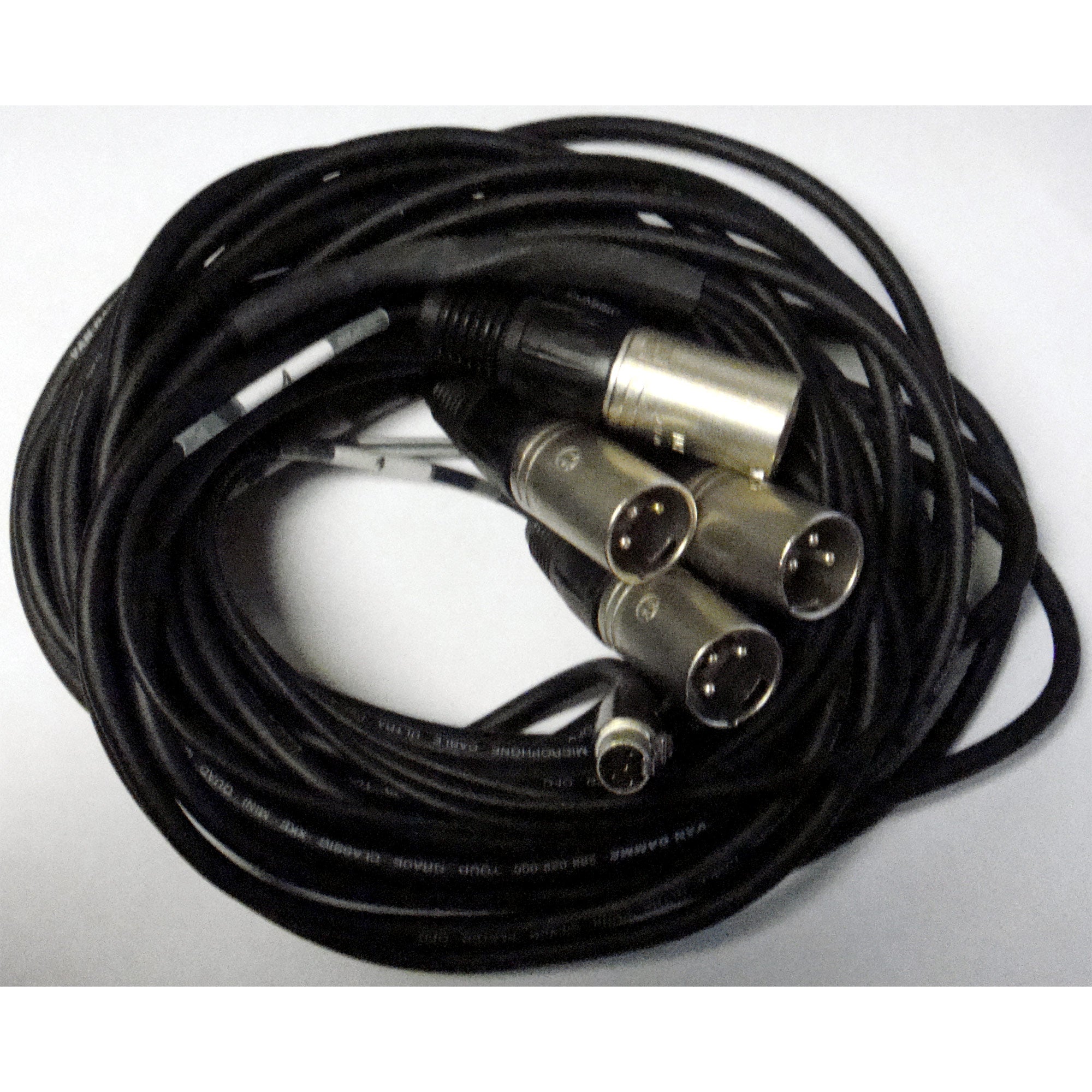
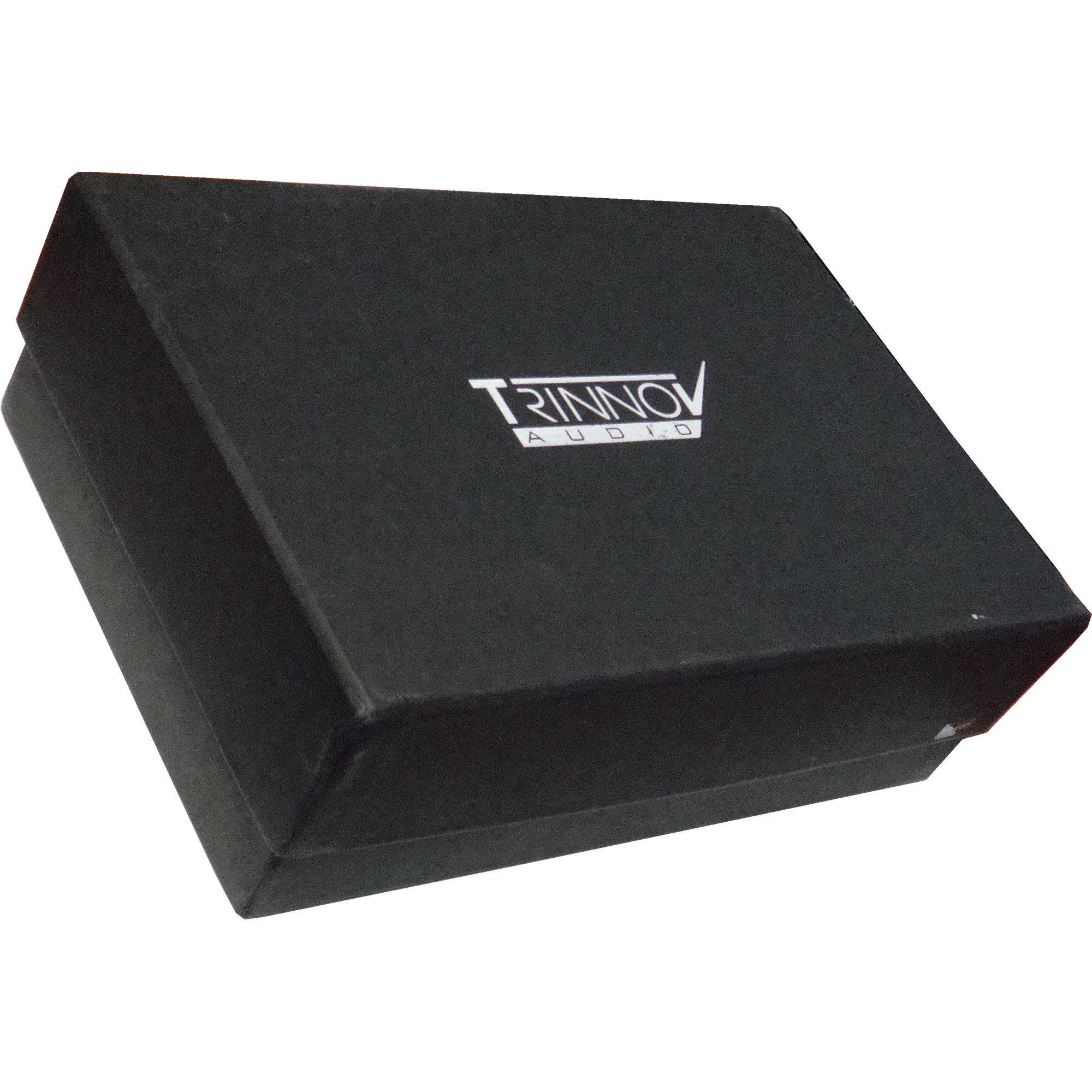
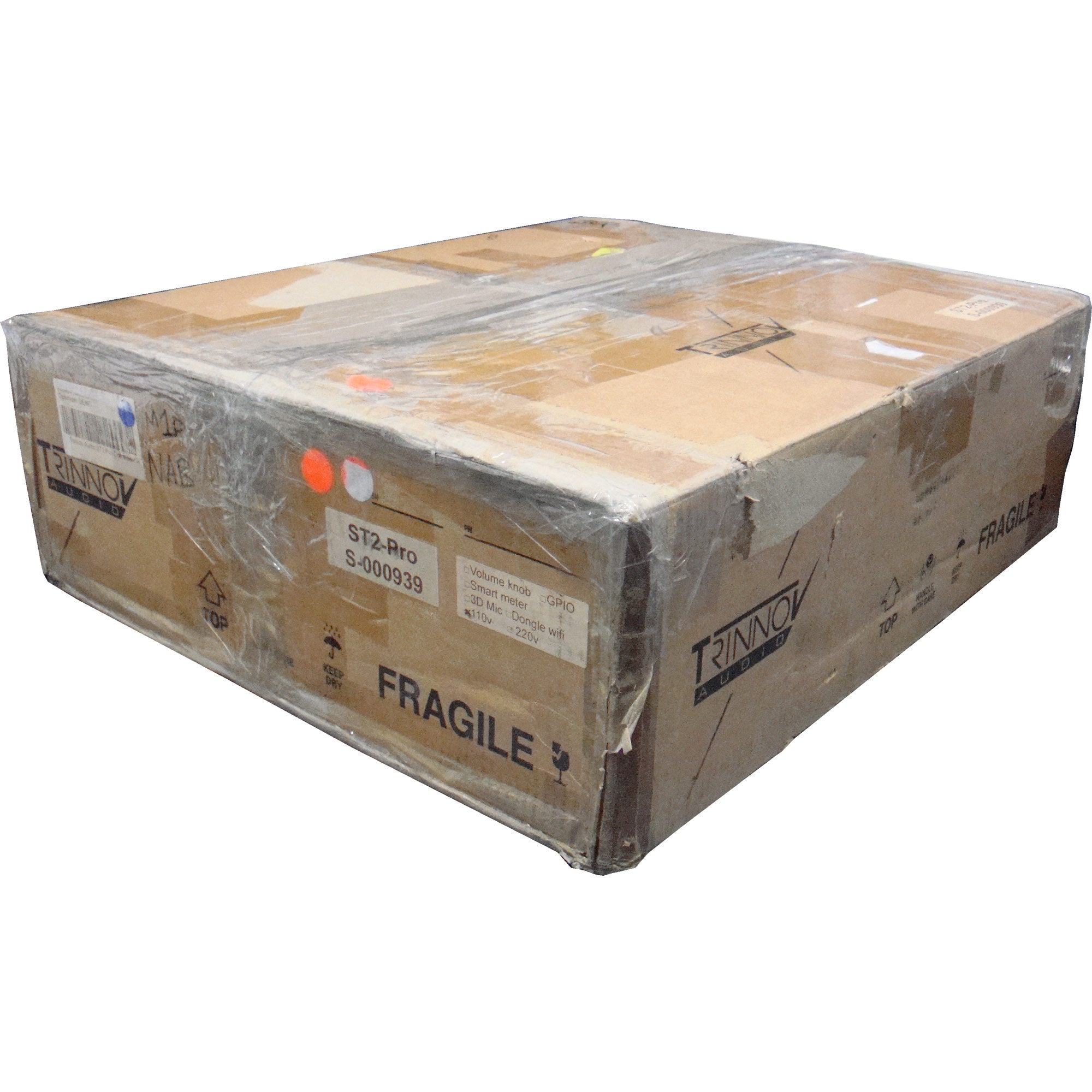
Trinnov Audio Bundle - ST2 Pro Monitor Controller and 3D Microphone - B-Stock
Availability:
In StockAvailable for shipment within one business day, or pickup from our Jamaica, NY warehouse during regular business hours.

Description
The Optimizer provides you with a unique set of data and comprehensive toolbox to get the absolute best from your speakers in any given room. With a single measurement, the Optimizer gives you both the direct response and the global acoustic response of your speakers in the room. You can then define the target curve that will best meet your loudspeakers characteristics whilst optimizing its global acoustic response. The Optimizer automatically defines the filters that will achieve the required frequency response specified by your target curve. This is particularly useful in post-production studios to comply with SMPTE standards (X-Curve).
The Optimizer automatically time aligns your speakers with more precision than a human could achieve with a tape measure.
Time alignment alone makes a huge difference in terms of stereophonic image, but by working in the time domain and improving both the amplitude and phase response of the loudspeakers, the Optimizer achieves high-resolution stereophonic image and well-focused phantom sources simply not achievable otherwise.
3D MICROPHONE SPEAKER LOCALIZATION
The measurement microphone is one of the most critical components of a loudspeaker/room calibration system. Trinnov’s sophisticated algorithms not only rely on very accurate acoustic measurements but also on the ability to localize speakers positions and to detect early reflection provenance. Trinnov’s 3D measurement microphone is the result of our extensive research in 3D sound. We invested a significant amount of time to design a tailored measurement system that could gather very precise information regarding the spatial position of multiple sources.
This is called triangulation. Each of the four omnidirectional capsules is placed at the same distance from each other, forming a tetrahedral pattern. This allows us to localize each speaker’s placement on both horizontal and vertical planes.
To achieve this challenge, the microphone consists of 4 capsules mounted at the top of thin brass tubes to avoid diffraction.
SOUND TAILORED TO YOUR AUDIENCE
Trinnov’s sophisticated multipoint algorithm can take into account the measurements of different positions to perform the optimization. A higher weighting may be assigned to the most critical listening position(s), and lower weighting to the remaining points. Therefore you can create instantly recallable listening positions letting you listen at the sweetest spot wherever you or the producer may sit in the room, therefore making sure the production team hears the exact same content as you do.
The measurement microphone is one of the most critical components of any loudspeaker/room calibration system. Trinnov's sophisticated algorithms rely not only on extremely accurate acoustic measurements but also on the ability to localize the speakers' positions and to detect early reflections. This 3D microphone uses four mic elements in a precise tetrahedral arrangement. Each capsule is individually calibrated at the factory (±0.1 dB from 20 Hz to 24 kHz)
The resulting microphone calibration file is included in the microphone's box on a USB stick. This file is installed in the Trinnov product being employed and all subsequent measurements are filtered through the calibration coefficients to ensure accuracy.
As each speaker is measured, the resulting sound waves pass through this array of microphones, hitting each one at a slightly different time. Based on this timing, it can triangulate the location of the speaker from which the sound arrived. By testing each speaker in turn, it builds a three-dimensional map of where the speakers are relative to the mic (which is placed at the main listening position).
Trinnov can do this to within 2° of azimuth, 2° of elevation, and less than 1 cm of distance. They use this information to enable their proprietary Remapping technology, in which it translates from the theoretical rendering of the soundtrack to the specifics of your particular room. Remapping uses the two or three speakers closest to the intended location of a sound to create a phantom image of the sound coming from the correct direction.
Among other things, Remapping serves as a bit of a "Universal Translator" between the various audio formats. This is especially important in home cinemas since all three Immersive Audio formats disagree about the specific details of where you should place your speakers. This solves that problem for you.
| ANALOG & DIGITAL I/O | |
| ANALOG I/O | 4 channel input via 4 XLR (20kΩ) 4 channel output via 4 XLR (100 Ω) |
| AES I/O | 4 channel input via 2 XLR (110 Ω) 4 channel output via 2 XLR (110 Ω) |
| WORD CLOCK | 1 in / 1 out (BNC) |
| HARDWARE OPTIONS | 8 in / 4out GPIO REMOTE OPTION Permits preset status & recall from any external devices equipped with GPIO commands (DB25 connector) |
| AUDIO SPECIFICATIONS | |
| ADC Resolution / Sampling Rate | 24 Bits/96 Khz |
| DAC Resolution / Sampling Rate | 24 Bits/96Khz |
| A/D Signal-To-Noise Ratio | 119 Db (A-Weighted) |
| D/A Signal-To-Noise Ratio | 118 Db (A-Weighted) |
| Analog Input Impedance | Balanced: 20 Kohms |
| Reference Level | +18Dbu @ 0Dbfs (Balanced) |
| Clock / Jitter | (Jitter Attenuation > 50 Db Above 100Hz) |
| PHYSICAL CHARACTERISTICS | |
| Power | Dedicated linear power supply with a toroidal transformer on the analog audio circuit. Dedicated PSU / switch-mode power supply on the digital audio circuit. Power supply: 240V AC / 50-60 Hz. Option: 130V AC Consumption: 90 W max.Weight: ∼14.5kg Chassis: 2U |
The Optimizer provides you with a unique set of data and comprehensive toolbox to get the absolute best from your speakers in any given room. With a single measurement, the Optimizer gives you both the direct response and the global acoustic response of your speakers in the room. You can then define the target curve that will best meet your loudspeakers characteristics whilst optimizing its global acoustic response. The Optimizer automatically defines the filters that will achieve the required frequency response specified by your target curve. This is particularly useful in post-production studios to comply with SMPTE standards (X-Curve).
The Optimizer automatically time aligns your speakers with more precision than a human could achieve with a tape measure.
Time alignment alone makes a huge difference in terms of stereophonic image, but by working in the time domain and improving both the amplitude and phase response of the loudspeakers, the Optimizer achieves high-resolution stereophonic image and well-focused phantom sources simply not achievable otherwise.
3D MICROPHONE SPEAKER LOCALIZATION
The measurement microphone is one of the most critical components of a loudspeaker/room calibration system. Trinnov’s sophisticated algorithms not only rely on very accurate acoustic measurements but also on the ability to localize speakers positions and to detect early reflection provenance. Trinnov’s 3D measurement microphone is the result of our extensive research in 3D sound. We invested a significant amount of time to design a tailored measurement system that could gather very precise information regarding the spatial position of multiple sources.
This is called triangulation. Each of the four omnidirectional capsules is placed at the same distance from each other, forming a tetrahedral pattern. This allows us to localize each speaker’s placement on both horizontal and vertical planes.
To achieve this challenge, the microphone consists of 4 capsules mounted at the top of thin brass tubes to avoid diffraction.
SOUND TAILORED TO YOUR AUDIENCE
Trinnov’s sophisticated multipoint algorithm can take into account the measurements of different positions to perform the optimization. A higher weighting may be assigned to the most critical listening position(s), and lower weighting to the remaining points. Therefore you can create instantly recallable listening positions letting you listen at the sweetest spot wherever you or the producer may sit in the room, therefore making sure the production team hears the exact same content as you do.
The measurement microphone is one of the most critical components of any loudspeaker/room calibration system. Trinnov's sophisticated algorithms rely not only on extremely accurate acoustic measurements but also on the ability to localize the speakers' positions and to detect early reflections. This 3D microphone uses four mic elements in a precise tetrahedral arrangement. Each capsule is individually calibrated at the factory (±0.1 dB from 20 Hz to 24 kHz)
The resulting microphone calibration file is included in the microphone's box on a USB stick. This file is installed in the Trinnov product being employed and all subsequent measurements are filtered through the calibration coefficients to ensure accuracy.
As each speaker is measured, the resulting sound waves pass through this array of microphones, hitting each one at a slightly different time. Based on this timing, it can triangulate the location of the speaker from which the sound arrived. By testing each speaker in turn, it builds a three-dimensional map of where the speakers are relative to the mic (which is placed at the main listening position).
Trinnov can do this to within 2° of azimuth, 2° of elevation, and less than 1 cm of distance. They use this information to enable their proprietary Remapping technology, in which it translates from the theoretical rendering of the soundtrack to the specifics of your particular room. Remapping uses the two or three speakers closest to the intended location of a sound to create a phantom image of the sound coming from the correct direction.
Among other things, Remapping serves as a bit of a "Universal Translator" between the various audio formats. This is especially important in home cinemas since all three Immersive Audio formats disagree about the specific details of where you should place your speakers. This solves that problem for you.
| ANALOG & DIGITAL I/O | |
| ANALOG I/O | 4 channel input via 4 XLR (20kΩ) 4 channel output via 4 XLR (100 Ω) |
| AES I/O | 4 channel input via 2 XLR (110 Ω) 4 channel output via 2 XLR (110 Ω) |
| WORD CLOCK | 1 in / 1 out (BNC) |
| HARDWARE OPTIONS | 8 in / 4out GPIO REMOTE OPTION Permits preset status & recall from any external devices equipped with GPIO commands (DB25 connector) |
| AUDIO SPECIFICATIONS | |
| ADC Resolution / Sampling Rate | 24 Bits/96 Khz |
| DAC Resolution / Sampling Rate | 24 Bits/96Khz |
| A/D Signal-To-Noise Ratio | 119 Db (A-Weighted) |
| D/A Signal-To-Noise Ratio | 118 Db (A-Weighted) |
| Analog Input Impedance | Balanced: 20 Kohms |
| Reference Level | +18Dbu @ 0Dbfs (Balanced) |
| Clock / Jitter | (Jitter Attenuation > 50 Db Above 100Hz) |
| PHYSICAL CHARACTERISTICS | |
| Power | Dedicated linear power supply with a toroidal transformer on the analog audio circuit. Dedicated PSU / switch-mode power supply on the digital audio circuit. Power supply: 240V AC / 50-60 Hz. Option: 130V AC Consumption: 90 W max.Weight: ∼14.5kg Chassis: 2U |
Your home for all things pro audio—backed by expertise and experience. Connect with us today.
Your home for all things pro audio—backed by expertise and experience. Connect with us today.

